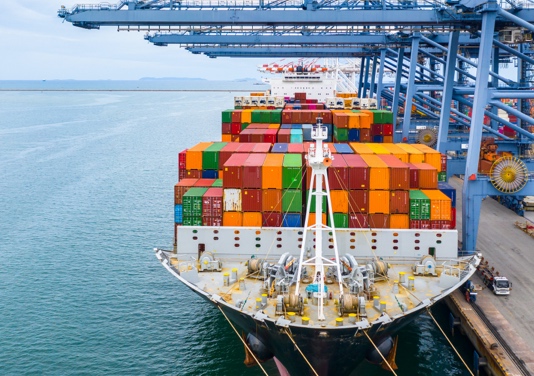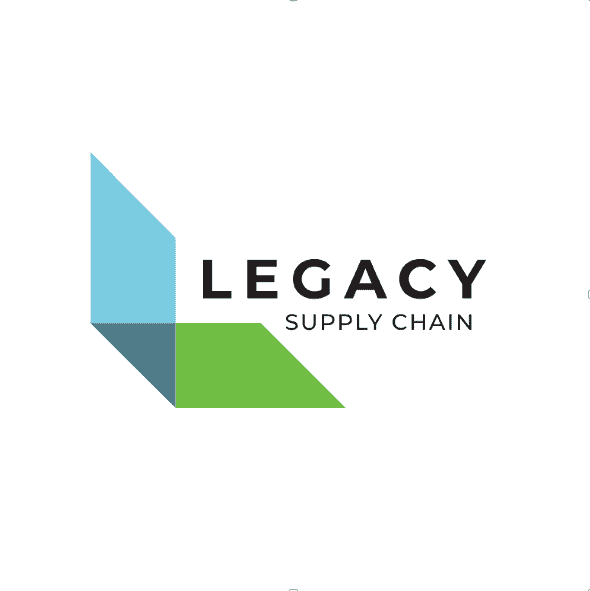Issue 38: Junes Shipment, Shipping Delays, Industry Pressure, Tax Loopholes and more

A WORD FROM LEGACY
Welcome to the Monthly Shipment for June, as a slow May brings another record low for the Logistics Managers’ Index, as well as its first contraction. But it’s not all bad news, as we’re happy to report positive developments on labor disputes and transportation woes. Plus, stories on sustainability pressures and potential legislation to restrict eCommerce imports.
Read on for this month’s Shipment, starting with our regular Market Update.
MARKET UPDATE
A Slow May Sees the LMI Hit Its Third Consecutive Record Low
Let’s get the bad news out of the way first: The Logistics Managers’ Index (LMI) for May reached a new all-time low with a reading of 47.3. This marks its third consecutive month of decline and the first time it’s entered contraction territory in its six-and-a-half year history. The drop is primarily attributed to the softening freight market, where the glut of available capacity has driven down Transportation Utilization and Transportation Prices to readings of 45.5 (-9.5) and 27.9 (-8.9), respectively.
Though we’re seeing contraction throughout the supply chain, it’s sharpest for the upstream players such as wholesalers, manufacturers and the B2B carriers that connect them. The LMI decline in May was largely driven by inventory shifts, with a noticeable contraction in the latter half of the month. Inventory Costs remained high with only a -0.7 decline, and Warehousing Prices continued to grow, albeit at a slower rate. Warehousing Capacity has now expanded for four consecutive months, while Warehousing Utilization experienced a slight -0.5 decline.
The overall economy continues to be influenced by shifting interest rates, with the U.S. Federal Reserve pausing its interest rate increases amid issues in the banking industry. Job growth remained strong in sectors relevant to the logistics industry, such as construction, engineering, transportation and warehousing. However, manufacturing and transportation were impacted by higher interest rates, as reflected in the decline of the manufacturing index (46.9) and the contraction of the logistics industry.
The freight market’s struggle is attributed to reduced volumes and mismatched supply and demand. Transportation Capacity continued to grow but at a slower rate, while Transportation Utilization has now entered contraction territory. Transportation Prices reached an all-time low, influenced by decreased demand and lower diesel prices.
Without inventory influx for the holiday season, the freight market will continue to face challenges. The potential ramp-up of goods is uncertain, with industry groups all having differing opinions. Despite not seeing their usual peak season bookings through June or July, DHL and SEKO logistics report that they are “cautiously optimistic” that volumes will return in the second half of the year.
Internationally, the Eurozone experienced a decline in inflation, leading to a potential pause in interest rate increases by the European Central Bank. China’s rapid recovery from the COVID-19 pandemic has slowed, primarily due to underlying issues in the economy and geopolitical tensions, affecting foreign investment and international logistics.
Overall, the logistics industry faces contraction and significant challenges in various sectors, including transportation, warehousing and inventory management. While the continued contraction has been tough on carriers, the silver lining could be that decreased logistics costs are helping to slow down U.S. inflation, which may lead to a slowdown in interest rates and eventual recovery in the freight market.
There’s sure to be a rebound after we hit bottom, but the unpleasant question remains — how far away is it?
For a complete overview of the May 2023 LMI across all indices, please refer to the following chart:
LOGISTICS AT A GLANCE
| Index | May 2023 Index | April 2023 Index | Month-Over-Month Change | Projected Direction | Rate of Change |
| LMI® | 47.3 | 50.9 | -3.6 | Contracting | From Expansion |
| Inventory Levels | 49.5 | 50.9 | -1.5 | Contracting | From Expansion |
| Inventory Costs | 64.4 | 65.1 | -0.7 | Expanding | Slower |
| Warehousing Capacity | 56.7 | 54.7 | 2.0 | Expanding | Faster |
| Warehousing Utilization | 54.7 | 55.1 | -0.5 | Expanding | Slower |
| Warehousing Prices | 62.8 | 69.8 | -7.0 | Expanding | Slower |
| Transportation Capacity | 69.3 | 70.6 | -1.3 | Expanding | Slower |
| Transportation Utilization | 45.5 | 55.0 | -9.5 | Contracting | From Expansion |
| Transportation Prices | 27.9 | 36.8 | -8.9 | Contracting | Faster |
Logistics at a Glance chart depicting month-over-month changes across various indices from April 2023 to May 2023, including projected direction and rate of change.
Also in Today’s Shipment:
- An update on contract negotiations on the West Coast and shipping delays on the East Coast.
- All eyes on UPS amid contract negotiations with the International Brotherhood of Teamsters.
- The shipping industry faces increased scrutiny as sustainability measures gain momentum.
- US lawmakers seek to repeal de minimis rule for Chinese and Russian imports.
IN THE NEWS
BRIEF
Shipping Delays Averted on Both West and East Coasts

Let’s move on to some good news. After numerous calls for the White House to intervene in the West Coast ports labor negotiations, the year-long labor-related disruptions have finally come to an end. On June 14, the International Longshore and Warehouse Union (ILWU) and the Pacific Maritime Association (PMA) employer group reached a tentative agreement on a new six-year contract that covers the 29 ports and 22,000 workers responsible for most U.S. imports.
The White House released a statement from President Biden about the labor agreement, thanking acting U.S. Labor Secretary Julie Su for working with both parties throughout “sometimes acrimonious negotiations” in helping “assure that our supply chains remain strong for America’s businesses, farmers, and working families.”
While the deal appears to end an 11-month disagreement over wages and the role of automation, which resulted in work slowdowns at the ports of Los Angeles and Long Beach, Union members still need to ratify in the coming months. As of the release of this report, the exact details of the agreement haven’t been released, and it still requires ratification by the PMA and union members — so let’s keep those fingers crossed. In a new development last week, the ILWU has given notice to strike at Canadian west coast ports. The move is not expected to risk the US agreement.
We also have good news on the U.S. East Coast, after the trucking industry feared for the worst for transportation delays after a deadly accident on June 11 caused the collapse of a section of I-95 in Philadelphia. Thankfully, those fears were unfounded, as temporary lanes were successfully opened on Friday, June 23.
At a ceremony to celebrate the reopening, Pennsylvania Governor Josh Shapiro joined with government and union officials to thank all those involved in the project. Over 200 building trades members worked around the clock — and through the Father’s Day weekend — to rebuild the portion of the severed section, a project which was 100% federally funded.
The haste is appreciated, as ground traffic in the U.S. looks to pick up in the summer. The American Automobile Association projects that more Americans will be planning trips over the next few months, with Senior Vice President of AAA Travel Paula Twidale noting that “This summer travel season could be one for the record books.”
Summer’s only just begun, but let’s give thanks that both of these shipping woes have been resolved.
UPDATE
UPS Contract Negotiations Continue; Shift to Economic Proposals

Speaking of union contract negotiations, all eyes are currently on the International Brotherhood of Teamsters (IBT) and UPS as they work to come to an agreement before the renewal of IBT’s contract on July 31, 2023. In our May issue, we noted that both sides had reached an agreement on some non-economic issues; since then, both parties have also reached agreement on all non-economic topics. But unfortunately, as of June 23, the IBT and UPS remain on opposing sides regarding wages and benefits.
While IBT’s General President Sean O’Brien praised the efficiency of how negotiations have been so far, he was far more stern in the official statement released by the IBT on their Facebook page:
“The Teamsters will not bargain or accept any contract that’s cost-neutral. We are not going to sell ourselves short in these negotiations, and we will not buy back terms and conditions to protect our members… We have 39 days to go. This company is wasting time putting forth offensive proposals. If UPS wants to negotiate a contract for 1997 working conditions, they’re going to get 1997 consequences.”
Kara Deniz, a spokesperson for IBT, also bluntly laid out the union’s position, stating “[Our workers] are busting their butts, they are working hard. And so they deserve every bit of their share of how profitable this company has been.” UPS’ profits have risen to $11.5 billion since the last five-year contract negotiation between the Teamsters and UPS in 2018, due largely to the rise in online shipping during the pandemic lockdown.
In a statement released on Thursday, June 22, UPS wrote that they were “prepared to be at the table every day until we reach an agreement that allows us to continue rewarding our people with the best pay and benefits package in the industry while providing the flexibility our business needs to deliver for our customers and consumers.”
REPORT
Shipping Industry Faces Mounting Sustainability Pressures
The shipping industry finds itself in the crosshairs of the International Maritime Organization (IMO) ahead of its Marine Environment Protection Committee meeting this coming July 3-7. International shipping just dodged a bullet at the recent climate and finance summit in Paris, which ended without an announcement of any major reforms. However, out of those discussions, 23 countries and regional organizations supported the adoption of the principle of a levy on shipping’s greenhouse gas emissions.
French President Emmanuel Macron, who hosted the summit, noted that international shipping was a “tax-free sector,” adding,“there’s no reason why it’s not taxed.” The discussion of a possible global tax on greenhouse gas emissions is expected to continue at the IMO’s meeting next month. As of its fourth greenhouse gas emissions study, the IMO estimated that share of shipping emissions in global anthropogenic emissions was at 2.89%
This isn’t the first challenge to the shipping industry’s tax-free status, as the European Union has agreed that — starting next year — shipping companies will have to buy EU carbon permits to cover 40% of their emissions, rising to 70% in 2025 and 100% in 2026. The rule applies to all shipping within the EU as well as half of all emissions from shipping that begins or ends in the EU.
This increased scrutiny on shipping follows a trend of rising pressure on companies to ensure that supply chains meet global sustainability goals. According to the past two years of the State of Supply Sustainability Report, pressure from investors, corporate buyers, executives and consumers for more action on supply chain sustainability have risen dramatically, even in the face of economic contraction and the Russian invasion of Ukraine.
A reminder that, as of January 2023, it is now mandatory for ships to calculate their attained Energy Efficiency Existing Ship Index and to initiate the collection of data for their annual operational carbon intensity indicator certification. The first annual reporting will be completed by the end of the year, with initial ratings set to be given in 2024.
DEVELOPING
U.S. Lawmakers Seek to Remove Tax Loophole from Chinese eCommerce Imports

There are few things that can bring about bipartisan support in Congress; imposing tariffs is one of them. Both houses of Congress are now targeting eCommerce imports from China and Russia. Two bills, introduced in the House of Representatives and in the Senate, are seeking to eliminate what’s known as the de minimis rule — an exemption from duties and taxes for shipments valued less than $800 that are shipped to individual consumers — for eCommerce imports from both China and Russia.
U.S. Congressman Earl Blumenauer, who reintroduced The Import Security and Fairness Act, which failed to pass Congress last year, stated that:
“The de minimis loophole is a threat to American competitiveness, consumer safety, and basic human rights. It is used by primarily Chinese companies to ship over two million packages a day into the United States. It puts American businesses at a competitive disadvantage while flooding American consumers with undoubtedly harmful products.There is virtually no way to tell whether packages that come in under the de minimis limit contain products made with forced labor, intellectual property theft, or are otherwise dangerous. It is time to close this loophole once and for all.”
Experts say that if the de minimis rule is repealed for Chinese imports, it could directly affect online shopping platforms such as fast-fashion retailer Shein and PDD Holdings’ Temu.
De minimis shipments have drawn greater attention since the U.S. Consumer Product Safety Commission’s 2019 report, where it stated it was “extremely challenging for the CPSC to keep pace with the rise of e-commerce, which has led to a significant increase in volume of low-value, potentially noncompliant or hazardous shipments of foreign-manufactured products that are shipped directly to consumers.” In addition to duty exemptions, de minimis shipments can enter the country without undergoing U.S. Customs and Border Protection inspection.
Under Representative’s Blumenauerther’s bill, only private carriers such as FedEx, UPS and DHL would be able to transport de minimis packages. Countries other than China and Russia could keep the exemption by adopting the $800 threshold for their own tariff-free imports. The bill would also exclude postal services. A separate bill, the De Minimis Reciprocity Act, includes a provision to lower the current de minimis threshold.
Thank you once again for joining us for this month’s Shipment. Be sure to follow our blog for updates on these stories and more, and browse our resource center for valuable logistics assets. For more specific information regarding logistics in your own organization, reach out to the Legacy team to get the conversation started.
See you next month!
Get Insights. Stay Ahead.
Get the latest news and insights via email on warehouse improvement, transportation optimization, labor strikes and international shipping rate changes.Popular Posts
Search Posts
-
2024 Q1 Freight Landscape: Trends, Challenges, and Predictions
As the first quarter of 2024 comes to an end, here are some observations over the past few months as well as predictions about the trucking...
+ Read more -
Baltimore Bridge Impact Assessment – Update
Following the recent Baltimore Bridge collapse and subsequent port closures, we want to keep our customers informed about the situation and...
+ Read more -
Global Momentum Builds for Charge on Global Shipping Sector’s CO2 Emissions
A growing coalition of 47 countries, including key players like the European Union, Canada, Japan, and various Pacific Island nations, is...
+ Read more










